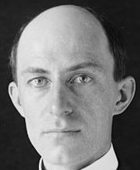Rationale for Inclusion
- Co-Inventor of the Airplane: Wilbur Wright, along with his brother Orville, is recognized as the co-inventor of the first successful powered airplane. The Wright brothers made history on December 17, 1903, when they achieved the first controlled, sustained flight of a powered, heavier-than-air machine with the Wright Flyer. Wilbur’s genius, particularly in solving the problem of flight control, was central to this groundbreaking achievement. Their success at Kitty Hawk, North Carolina, marked the dawn of the aviation age and forever changed transportation and the world.
- Pioneering Work on Flight Control: One of the Wright Brothers’ most critical contributions to aviation was his work on flight control systems, which enabled the Wright Flyer to achieve controlled flight. Orville and Wilbur developed a method for controlling the aircraft in all three axes of motion—pitch, roll, and yaw—using their innovative wing warping system and a moveable rudder. This system allowed for precise control of the aircraft, something that had eluded other early aviation pioneers. The brothers’ contributions to flight control were a significant breakthrough in aviation technology, laying the groundwork for modern flight controls used in today’s aircraft.
- Innovator in Aerodynamics: The Wright Brothers were pioneers in the field of aerodynamics, and his innovative research contributed to a deeper understanding of how air flows over wings. The Wright brothers designed and built their own wind tunnel, which allowed them to test different wing shapes and gather critical data on lift and drag. Wilbur’s experiments in aerodynamics helped him refine the design of the Wright Flyer, making it the first airplane capable of sustained flight. His work laid the groundwork for the modern science of aerodynamics.
- First Practical Airplane: After their initial success in 1903, the Wright brothers continued to improve their designs, and in 1905, Wilbur played a key role in the development of the Wright Flyer III, which is considered the first practical airplane. This aircraft was capable of flying for extended periods, performing controlled turns, and landing safely, making it a truly functional flying machine. Wilbur’s perseverance in perfecting the design ensured that aviation moved beyond brief hops to controlled, reliable flights, setting the stage for the development of the aviation industry.
- Enduring Legacy in Aviation: Wilbur Wright’s legacy in aviation is profound and enduring. He was a pioneer who not only invented the airplane but also laid the foundation for the modern aviation industry. His work on flight control, aerodynamics, and aircraft design continues to influence aviation to this day. The principles he and Orville developed are still applied in aircraft engineering, and the Wright brothers’ achievements remain an inspiration to aviators and engineers worldwide. Wilbur Wright’s contributions to aviation changed the course of history and continue to shape the future of flight.

Biography
- Early Life and Education: Wilbur Wright was born on April 16, 1867, in Dayton, Ohio. Wilbur attended high school in Dayton, where his passion for building and designing machinery flourished, though he did not graduate.
- Personal Life: Wilbur remained close to his brother Orville throughout his life, and their partnership would be one of the most significant in aviation history. Neither Orville nor Wilbur ever married or had children, dedicating their lives to their work and innovation.
- Early Career: Wilbur’s early career began with an interest in printing and mechanical design. In 1889, at just 22 years old, Wilbur, along with Orville, started a printing business, using a press they designed and built themselves. A few years later, the Wright brothers transitioned into the bicycle business, opening the Wright Cycle Company in 1892. By the late 1890s, Orville and Wilbur became fascinated with the idea of human flight, studying the work of earlier aviation pioneers and conducting their own experiments, which eventually led to their groundbreaking success with the Wright Flyer in 1903.
- Over the course of history, Wilbur received numerous awards and accolades, including:
- Induction into the National Aviation Hall of Fame (1962)
- Induction into the International Air & Space Hall of Fame (1965)
- Receipt of the Congressional Gold Medal (1909)
